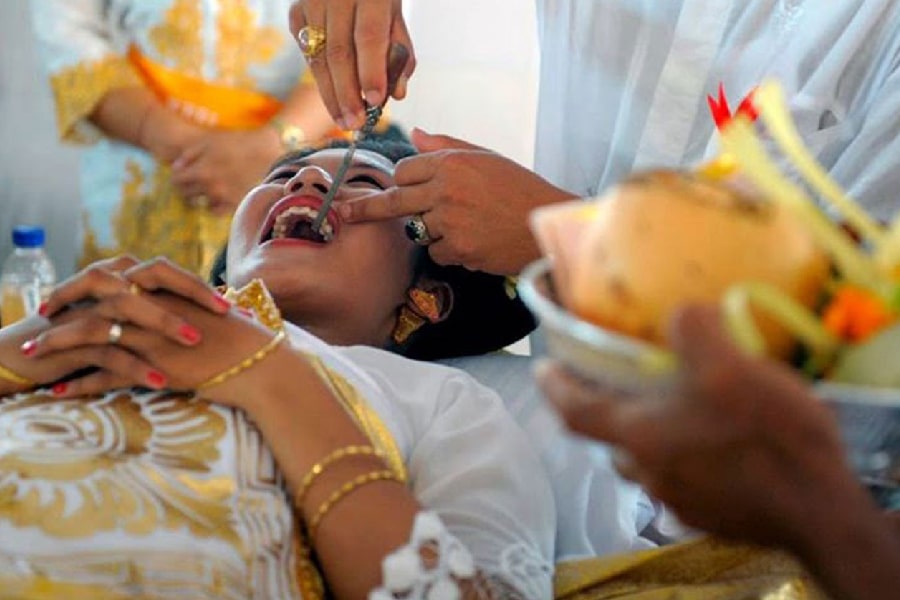Tooth Filing ceremony is belonging to the Manusa Yadnya (ceremony for humans). Called ‘Mapandes’ in High Balinese, ‘Metatah’ in Common Balinese. The reason for filing is to control evil human characteristics (Sad Ripu): greed, lust, anger, confusion, stupidity, jealousy, ill-will, and intoxication by either passion or drunkenness. This important life-cycle event usually occurs when a Balinese boy or girl reaches puberty-at a girl’s first menstruation, when a boy’s voice changes. If not then, it must definitely take place before marriage; sometimes Tooth Filing is incorporated into the marriage ceremony.
After Tooth Filing, a father’s duties to his female children are generally regarded as complete. Before a cremation the teeth of a cadaver may be filed. Why? Pointed teeth are likened to those of ferocious witches, demons, wild animals, savages, or, almost as bad, dogs. A person’s canine teeth, regarded by the Balinese as animalistic fangs (Caling), are filed flat so the child may become fully human, able to reign in the emotions.
It’s believed a Balinese may be denied entrance into heaven if the teeth are not filed because s/he might be mistaken for a wild creature. In the old days the teeth of adolescents were also blackened with betel nut to distinguish them from the white teeth of animals. ‘Mapandes‘ is a costly affair; invitations must be issued, musicians are hired, the fee of the ‘Pedanda’ is paid, elaborate offerings are carried out, and a banquet is prepared for guests and villagers.
Because of the great expense, it may be delayed until enough money has been saved. A number of families may participate in a mass tooth filing in order to share costs, or it may be held simultaneously with some other costly ceremony such as a cremation or wedding. The ‘Banjar’ often determines that financial help should be extended to the lower castes to enable them to participate. To view the maximum pomp and ritual, attend a Tooth Filing ceremony sponsored by a Brahman family, where as many as 14 people may participate and expenses could top Rp.35 million.
Tooth filing represents the evening out of the extreme and ‘Kasar’ (rough) aspects of one’s personality as one enters adulthood. Tooth filing also adds the person of the six evil animal passions that Balinese believe everyone possesses to some degree: laziness (alus), love of sensual pleasures (raga), love of luxury and splendor (dewasa), love of worldly goods (tresna), in difference (indra), and resoluteness (baja). Though representatives from each caste are in the tooth filing ceremony, a girl of the lower caste will be asked to lie on a platform at a lower level than her upper-caste sisters, and she wears less lavish ceremonial clothing.
The most important event of adolescence, Balinese endure it with not a sound of complaint. After the filing, youths of all castes can go on to lead healthy, well-adjusted lives as a part of Ball’s tightly knit family, clan, community and society. Tooth Filing is scheduled on an auspicious day and performed by a specialist Brahman priest on a special platform. For the occasion makeshift bamboo shrines with gay, colorful offerings of rice, sweet cakes, flowers, and fruits are erected within the compound.
All attendees dress in traditional clothing and the customary white cardboard box of snacks and bottle of sweetened tea is handed to all that enter. Having spent the previous two or three nights praying while confined in bale built for the occasion within the high-caste family’s compound, from two to 100 initiates are assembled, dressed in white and yellow to signify holiness. Girls wear precious ‘kemben’ (breast cloth), the finest the family can afford, with garments as ornate as those of legong dancers.
Boys wear a ‘songket’ from the armpits to the knees, a ‘kris’ protruding from a yellow sash in the back. The ceremony begins with the ‘pedanda’ sprinkling holy water and blessing the group with mantras. Offerings are placed before the gods of sexual love. The initiates lie down on the richly draped bamboo platform wide-eyed and frightened, clutching their pillows as close relatives ring around. Incense is lit, mouthwash placed at the ready, files and whetstones blessed to cleanse them and render the operation painless.
Magic symbols (aksara) are inscribed on the teeth. The “dentist” (sangging) first places a small cylinder of sugarcane in the corners of the mouth to prop the jaws open and prevent gagging. The front two upper canines are filed so they’re even with the upper incisors; it’s important to affect an even line of short teeth. The actual filing requires about five to 10 minutes. A mirror is provided to allow the patient to observe the progress of the ritual. Filings are spit into a yellow coconut.
Tears may roll down their cheeks, but the files seldom cry out. Sometimes members of the family sing a ‘kekawin’ about Arjuna, the brave young hero of the Mahabharata epic, to bolster the spirits of their loved ones, someone else may recite Kawi translated into vernacular Balinese. To lighten the atmosphere, the ‘sangging’ may joke with the file as he files. After consulting with his girlfriend, wife, or mother, a boy may decide he still possesses too much animalist and lie back down on the bed for more filing. Occasionally, there are requests for just a few token, symbolic strokes of the file.


